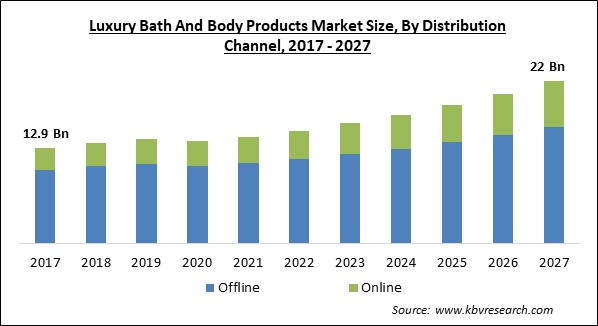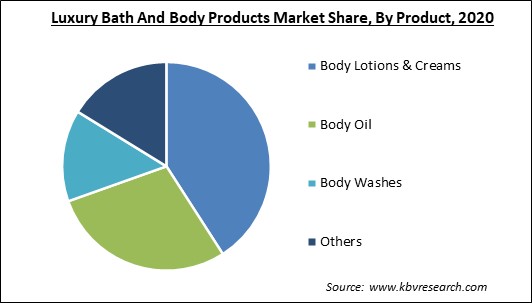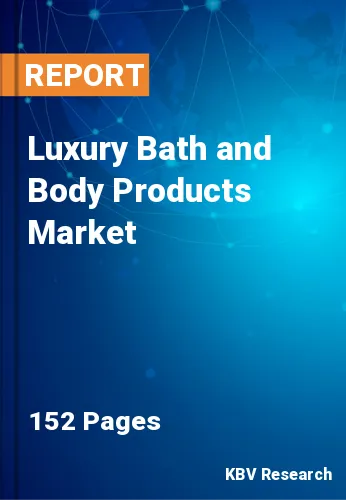The Global Luxury Bath And Body Products Market size is expected to reach $22 billion by 2027, rising at a market growth of 7.3% CAGR during the forecast period.
There is a growing demand for luxury items such as shower gels, lotions, and body wash in the market. In addition, the growing number of product releases in the premium class of creams and lotions is expected to cater to millennials and young people. With a growing emphasis on luxury and necessary body and bath products, a growing number of companies are offering a diverse range of products in various sectors. For example, in July 2020, Amorepacific Group exclusively partnered with Nykaa to increase the products of premium body care products brand Sulwhasoo in India. Consumers are also more likely to purchase luxury skincare products as a result of such product offers, which has been a major factor propelling the growth of the market.
Additionally, customers are increasingly taking charge of their health, which has resulted in the rise of bath & body care sectors such as sleep, anti-pollution, and self-care. The demand for bath and body products made with organic and natural components is likely to increase over the forecast period. Luxury bath and body items have grown to include a diverse range of goods and styles. Key market companies are broadening their horizons by developing performance-based showers as well as aromatherapy utilizing biotechnology expertise. Massey Medicinals, for example, provides the Candida Freedom handmade luxury product line, which comprises biodegradable bath soaps, oils, and bath salts prepared with Sabinsa's LactoSpore.

The COVID-19 pandemic caused a severe impact on various economies all over the world. Several businesses were significantly devastated as a result of the outbreak of the COVID-19 infection. In addition, the governments of several countries were forced to impose lockdowns in their nations. As a result, the manufacturing units of numerous goods were temporarily shut. Moreover, these lockdowns also caused a major disruption in the supply chain of various goods. Further, the COVID-19 led the worldwide healthcare industry to a significant failure due to the shortage of beds and oxygen in hospitals. However, the luxury bath and body products market observed a surge in the demand for natural and organic products for sanitization and hygiene.
Due to the increased emphasis on essential and luxury body and bath products, a growing number of enterprises are offering a diverse range of products in various sectors. Vegan, organic, cruelty-free, paraben-free, sulfate-free, and herbal goods are among the options. Natural ingredients-based products have grown in popularity in recent years due to their non-toxic and safe nature. Customers are becoming more conscious of the negative impacts of chemicals and synthetic alternatives that are widely being employed in numerous bath and body care products, on their health. Moreover, in the recent years, the organic and natural luxury bath and body products are significantly being demanded in several countries all over the world. In order to fulfill the rising demand for enhanced and premium quality luxury bath and body products, various major market players along with numerous new market entrants are constantly expanding their product portfolios.
Biotechnology knowledge is being sought by players in order to develop high-performance bath and body products that will appeal to customers. Additionally, due to their proven benefits of healthy and beautiful skin, products built on micro-biome technology are in high demand. JooMoo Ltd., for example, has created a body wash based on its Microbiota Immune Response Regulation (MIRR) technology. Companies are majorly emphasizing on introducing more formulations that are inspired by biotechnology in their products. Moreover, luxury bath and body products businesses are also developing various medicated bath and body products that are based on biotechnical formulations. These products are customized for almost every skin type including oily, dry, and over-hydrated.
Several bath and shower products include harmful substances like formaldehyde or 1,4-dioxane, which can cause rashes or allergic responses on the skin. Due to this, consumers are becoming hesitant in purchasing these products. Preservatives such as butylparaben and methylparaben are also regularly found in Bath and Body products. Endocrine disruptors, or chemicals that interfere with the body's natural hormone activity, are known as parabens. This can cause or contribute to a variety of unfavorable health consequences, such as cancer, infertility, and reproductive issues. Parabens can also irritate the skin by causing inflammation in certain cases. Sulfates, such as Sodium Lauryl Sulfate and Sodium Laureth Sulfate, are another group of compounds to avoid in washing products like soaps and shampoos.

Based on Distribution Channel, the market is segmented into Offline and Online. In 2020, the online segment registered a significant revenue share of the luxury bath and body products market. Because of the growing popularity of online shopping around the world, internet channels have grown substantial prominence in recent years. Due to the increased visibility of various luxury brands, consumers all over the world are increasingly shifting to online shopping. Purchasing products online allows the customer to explore a wide line of products from suppliers all over the world. In addition, the online shopping paradigm also enables customers to purchase goods online and receive them on their doorsteps. The major reason behind the growth of the online distribution channels is the convenience offered by this method to their customers.
Based on Product, the market is segmented into Body Lotions & Creams, Body Oil, Body Washes, and Others. In 2020, the body lotion and cream segment acquired the largest revenue share of the luxury bath and body products market. Creams and body lotions that contain niacinamide that improves the complexion and benefits the skin in order to provide 24-hour nourishment and hydration, contain key vitamins like A, E, and C, and restore smooth texture and firmness are becoming popular among millennials and Gen Z. Moreover, body lotions are easy to apply as well as do not need to be wiped off once applied. Due to these characteristics, luxury creams and body lotions are anticipated to be in high demand over the forecasting years.
| Report Attribute | Details |
|---|---|
| Market size value in 2020 | USD 13.9 Billion |
| Market size forecast in 2027 | USD 22 Billion |
| Base Year | 2020 |
| Historical Period | 2017 to 2019 |
| Forecast Period | 2021 to 2027 |
| Revenue Growth Rate | CAGR of 7.3% from 2021 to 2027 |
| Number of Pages | 151 |
| Number of Tables | 260 |
| Report coverage | Market Trends, Revenue Estimation and Forecast, Segmentation Analysis, Regional and Country Breakdown, Companies Strategic Developments, Company Profiling |
| Segments covered | Product, Distribution Channel, Region |
| Country scope | US, Canada, Mexico, Germany, UK, France, Russia, Spain, Italy, China, Japan, India, South Korea, Singapore, Malaysia, Brazil, Argentina, UAE, Saudi Arabia, South Africa, Nigeria |
| Growth Drivers |
|
| Restraints |
|
Based on Regions, the market is segmented into North America, Europe, Asia Pacific, and Latin America, Middle East & Africa. In 2020, Asia-Pacific held a promising revenue share of the luxury bath and body products market. Because of the spa-style along with the aromatherapy delight that luxury items provide, an increasing number of people are seeking them out for bathing as well as individual use. Additionally, customers desire to live a healthy and elite lifestyle, avoid ailments, and improve their overall mental and physical well-being. In contrast, market players across the region are introducing various organic and natural products, which would meet the consumers demand for enhanced mental and physical health.
Free Valuable Insights: Global Luxury Bath and Body Products Market size to reach USD 22 Billion by 2027
The market research report covers the analysis of key stake holders of the market. Key companies profiled in the report include The Estée Lauder Companies, Inc., Chanel S.A., Aromatherapy Associates (Walgreens Boots Alliance group), Kao Corporation, Diptyque (Manzanita Capital Ltd.), Chantecaille Beauté (Beiersdorf AG), Susanne Kaufmann Kosmetik GmbH, Bamford Ltd., ASC Regenity, Inc. (Augustinus Bader), and Tata's Natural Alchemy, LLC.
By Distribution Channel
By Product
By Geography
The global luxury bath and body products market size is expected to reach $22 billion by 2027.
Expanding body products portfolios of companies are driving the market in coming years, however, high cost along with the use of toxic ingredients in the products have limited the growth of the market.
The Estée Lauder Companies, Inc., Chanel S.A., Aromatherapy Associates (Walgreens Boots Alliance group), Kao Corporation, Diptyque (Manzanita Capital Ltd.), Chantecaille Beauté (Beiersdorf AG), Susanne Kaufmann Kosmetik GmbH, Bamford Ltd., ASC Regenity, Inc. (Augustinus Bader), and Tata's Natural Alchemy, LLC.
Yes, Due to COVID-19 the luxury bath and body products market observed a surge in the demand for natural and organic products for sanitization and hygiene.
The Offline segment acquired the maximum revenue share in the Global Luxury Bath And Body Products Market by Distribution Channel 2020; thereby, achieving a market value of $15.7 billion by 2027.
The North America market dominated the Global Luxury Bath And Body Products Market by Region 2020, and would continue to be a dominant market till 2027; thereby, achieving a market value of $7.4 billion by 2027.
Our team of dedicated experts can provide you with attractive expansion opportunities for your business.

